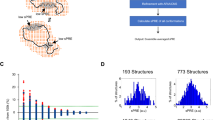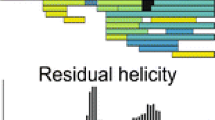Abstract
Application of typical HDX methods to examine intrinsically disordered proteins (IDP), proteins that are natively unstructured and highly dynamic at physiological pH, is limited because of the rapid exchange of unprotected amide hydrogens with solvent. The exchange rates of these fast exchanging amides are usually faster than the shortest time scale (10 s) employed in typical automated HDX-MS experiments. Considering the functional importance of IDPs and their association with many diseases, it is valuable to develop methods that allow the study of solution dynamics of these proteins as well as the ability to probe the interaction of IDPs with their wide range of binding partners. Here, we report the application of time window expansion to the millisecond range by altering the on-exchange pH of the HDX experiment to study a well-characterized IDP; the activation domain of the nuclear receptor coactivator, peroxisome proliferator-activated receptor gamma coactivator-1 alpha (PGC-1α). This method enabled mapping the regions of PGC-1α that are stabilized upon binding the ligand binding domain (LBD) of the nuclear receptor peroxisome proliferator-activated receptor gamma (PPARγ). We further demonstrate the method’s applicability to other binding partners of the IDP PGC-1α and pave the way for characterizing many other biologically important ID proteins.

ᇵ





Similar content being viewed by others
References
Dunker, A.K., Lawson, J.D., Brown, C.J., Williams, R.M., Romero, P., Oh, J.S., Oldfield, C.J., Campen, A.M., Ratliff, C.M., Hipps, K.W., Ausio, J., Nissen, M.S., Reeves, R., Kang, C., Kissinger, C.R., Bailey, R.W., Griswold, M.D., Chiu, W., Garner, E.C., Obradovic, Z.: Intrinsically disordered protein. J. Mol. Graph. Model. 19, 26–59 (2001)
Sigler, P.B.: Transcriptional activation. Acid blobs and negative noodles. Nature 333, 210–212 (1988)
Wright, P.E., Dyson, H.J.: Intrinsically unstructured proteins: reassessing the protein structure-function paradigm. J. Mol. Biol. 293, 321–331 (1999)
Uversky, V.N., Gillespie, J.R., Fink, A.L.: Why are "natively unfolded" proteins unstructured under physiologic conditions? Proteins 41, 415–427 (2000)
Uversky, V.N., Oldfield, C.J., Dunker, A.K.: Intrinsically disordered proteins in human diseases: introducing the D2 concept. Annu. Rev. Biophys. 37, 215–246 (2008)
Romero, P., Obradovic, Z., Li, X., Garner, E.C., Brown, C.J., Dunker, A.K.: Sequence complexity of disordered protein. Proteins 42, 38–48 (2001)
Ward, J.J., Sodhi, J.S., McGuffin, L.J., Buxton, B.F., Jones, D.T.: Prediction and functional analysis of native disorder in proteins from the three kingdoms of life. J. Mol. Biol. 337, 635–645 (2004)
Weathers, E.A., Paulaitis, M.E., Woolf, T.B., Hoh, J.H.: Reduced amino acid alphabet is sufficient to accurately recognize intrinsically disordered protein. FEBS Lett. 576, 348–352 (2004)
Sickmeier, M., Hamilton, J.A., LeGall, T., Vacic, V., Cortese, M.S., Tantos, A., Szabo, B., Tompa, P., Chen, J., Uversky, V.N., Obradovic, Z., Dunker, A.K.: DisProt: the database of disordered proteins. Nucleic Acids Res. 35, D786–D793 (2007)
Dosztanyi, Z., Csizmok, V., Tompa, P., Simon, I.: IUPred: web server for the prediction of intrinsically unstructured regions of proteins based on estimated energy content. Bioinformatics 21, 3433–3434 (2005)
Dunker, A.K., Brown, C.J., Lawson, J.D., Iakoucheva, L.M., Obradovic, Z.: Intrinsic disorder and protein function. Biochemistry 41, 6573–6582 (2002)
Oldfield, C.J., Cheng, Y., Cortese, M.S., Brown, C.J., Uversky, V.N., Dunker, A.K.: Comparing and combining predictors of mostly disordered proteins. Biochemistry 44, 1989–2000 (2005)
Dyson, H.J., Wright, P.E.: Coupling of folding and binding for unstructured proteins. Curr. Opin. Struct. Biol. 12, 54–60 (2002)
Lacy, E.R., Filippov, I., Lewis, W.S., Otieno, S., Xiao, L., Weiss, S., Hengst, L., Kriwacki, R.W.: p27 Binds cyclin-CDK complexes through a sequential mechanism involving binding-induced protein folding. Nat. Struct. Mol. Biol. 11, 358–364 (2004)
Xie, H., Vucetic, S., Iakoucheva, L.M., Oldfield, C.J., Dunker, A.K., Obradovic, Z., Uversky, V.N.: Functional anthology of intrinsic disorder. 3. Ligands, post-translational modifications, and diseases associated with intrinsically disordered proteins. J. Proteome Res. 6, 1917–1932 (2007)
Weinreb, P.H., Zhen, W., Poon, A.W., Conway, K.A., Lansbury Jr., P.T.: NACP, a protein implicated in Alzheimer's disease and learning, is natively unfolded. Biochemistry 35, 13709–13715 (1996)
Eliezer, D.: Biophysical characterization of intrinsically disordered proteins. Curr. Opin. Struct. Biol. 19, 23–30 (2009)
Wright, P.E., Dyson, H.J.: Linking folding and binding. Curr. Opin. Struct. Biol. 19, 31–38 (2009)
Zhang, X., Chien, E.Y., Chalmers, M.J., Pascal, B.D., Gatchalian, J., Stevens, R.C., Griffin, P.R.: Dynamics of the beta2-adrenergic G-protein coupled receptor revealed by hydrogen–deuterium exchange. Anal. Chem. 82, 1100–1108 (2010)
Zhang, J., Chalmers, M.J., Stayrook, K.R., Burris, L.L., Garcia-Ordonez, R.D., Pascal, B.D., Burris, T.P., Dodge, J.A., Griffin, P.R.: Hydrogen/deuterium exchange reveals distinct agonist/partial agonist receptor dynamics within vitamin D receptor/retinoid X receptor heterodimer. Structure 18, 1332–1341 (2010)
West, G.M., Chien, E.Y., Katritch, V., Gatchalian, J., Chalmers, M.J., Stevens, R.C., Griffin, P.R.: Ligand-dependent perturbation of the conformational ensemble for the GPCR beta2 adrenergic receptor revealed by HDX. Structure 19, 1424–1432 (2011)
Chalmers, M.J., Busby, S.A., Pascal, B.D., West, G.M., Griffin, P.R.: Differential hydrogen/deuterium exchange mass spectrometry analysis of protein–ligand interactions. Expert Rev. Proteom. 8, 43–59 (2011)
Englander, S.W.: Hydrogen exchange and mass spectrometry: A historical perspective. J. Am. Soc. Mass Spectrom. 17, 1481–1489 (2006)
Coales, S.J., Sook Yen, E., Lee, J.E., Ma, A., Morrow, J.A., Hamuro, Y.: Expansion of time window for mass spectrometric measurement of amide hydrogen/deuterium exchange reactions. Rapid Commun. Mass Spectrom. 24, 3585–3592 (2010)
Sharma, S., Zheng, H., Huang, Y.J., Ertekin, A., Hamuro, Y., Rossi, P., Tejero, R., Acton, T.B., Xiao, R., Jiang, M., Zhao, L., Ma, L.C., Swapna, G.V., Aramini, J.M., Montelione, G.T.: Construct optimization for protein NMR structure analysis using amide hydrogen/deuterium exchange mass spectrometry. Proteins 76, 882–894 (2009)
Pantazatos, D., Kim, J.S., Klock, H.E., Stevens, R.C., Wilson, I.A., Lesley, S.A., Woods Jr., V.L.: Rapid refinement of crystallographic protein construct definition employing enhanced hydrogen/deuterium exchange MS. Proc. Natl. Acad. Sci. U. S. A. 101, 751–756 (2004)
Mitchell, J.L., Trible, R.P., Emert-Sedlak, L.A., Weis, D.D., Lerner, E.C., Applen, J.J., Sefton, B.M., Smithgall, T.E., Engen, J.R.: Functional characterization and conformational analysis of the Herpesvirus saimiri Tip-C484 protein. J. Mol. Biol. 366, 1282–1293 (2007)
Hansen, J.C., Wexler, B.B., Rogers, D.J., Hite, K.C., Panchenko, T., Ajith, S., Black, B.E.: DNA binding restricts the intrinsic conformational flexibility of methyl CpG binding protein 2 (MeCP2). J. Biol. Chem. 286, 18938–18948 (2011)
Keppel, T.R., Howard, B.A., Weis, D.D.: Mapping unstructured regions and synergistic folding in intrinsically disordered proteins with amide H/D exchange mass spectrometry. Biochemistry 50, 8722–8732 (2011)
Simmons, D.A., Konermann, L.: Characterization of transient protein folding intermediates during myoglobin reconstitution by time-resolved electrospray mass spectrometry with on-line isotopic pulse labeling. Biochemistry 41, 1906–1914 (2002)
Rist, W., Rodriguez, F., Jorgensen, T.J., Mayer, M.P.: Analysis of subsecond protein dynamics by amide hydrogen exchange and mass spectrometry using a quenched-flow setup. Protein Sci. 14, 626–632 (2005)
Lin, J., Handschin, C., Spiegelman, B.M.: Metabolic control through the PGC-1 family of transcription coactivators. Cell Metab. 1, 361–370 (2005)
Burris, T.P., Busby, S.A., Griffin, P.R.: Targeting orphan nuclear receptors for treatment of metabolic diseases and autoimmunity. Chem. Biol. 19, 51–59 (2012)
Deblois, G., Giguere, V.: Functional and physiological genomics of estrogen-related receptors (ERRs) in health and disease. Biochim. Biophys. Acta 1812, 1032–1040 (2011)
Devarakonda, S., Gupta, K., Chalmers, M.J., Hunt, J.F., Griffin, P.R., Van Duyne, G.D., Spiegelman, B.M.: Disorder-to-order transition underlies the structural basis for the assembly of a transcriptionally active PGC-1α/ERRγ complex. Proc. Natl. Acad. Sci. U. S. A. 108, 18678–18683 (2011)
Bruning, J.B., Chalmers, M.J., Prasad, S., Busby, S.A., Kamenecka, T.M., He, Y., Nettles, K.W., Griffin, P.R.: Partial agonists activate PPARgamma using a helix 12 independent mechanism. Structure 15, 1258–1271 (2007)
Jin, L., Martynowski, D., Zheng, S., Wada, T., Xie, W., Li, Y.: Structural basis for hydroxycholesterols as natural ligands of orphan nuclear receptor RORγ. Mol. Endocrinol. 24, 923–929 (2010)
Chalmers, M.J., Busby, S.A., Pascal, B.D., He, Y., Hendrickson, C.L., Marshall, A.G., Griffin, P.R.: Probing protein/ligand interactions by automated hydrogen/deuterium exchange mass spectrometry. Anal. Chem. 78, 1005–1014 (2006)
Busby, S.A., Chalmers, M.J., Griffin, P.R.: Improving digestion efficiency under H/D exchange conditions with activated pepsinogen coupled columns. Int. J. Mass Spectrom. 259, 130–139 (2007)
Pascal, B.D., Willis, S., Lauer, J.L., Landgraf, R.R., West, G.M., Marciano, D., Novick, S., Goswami, D., Chalmers, M.J., Griffin, P.R.: HDX workbench: software for the analysis of H/D exchange MS data. J. Am. Soc. Mass Spectrom. 23, 1512–1521 (2012)
West, G.M., Pascal, B.D., Ng, L.M., Soon, F.F., Melcher, K., Xu, H.E., Chalmers, M.J., Griffin, P.R.: Protein conformation ensembles monitored by HDX reveal a structural rationale for abscisic acid signaling protein affinities and activities. Structure 21, 229–235 (2013)
Puigserver, P., Wu, Z., Park, C.W., Graves, R., Wright, M., Spiegelman, B.M.: A cold-inducible coactivator of nuclear receptors linked to adaptive thermogenesis. Cell 92, 829–839 (1998)
Greschik, H., Althage, M., Flaig, R., Sato, Y., Chavant, V., Peluso-Iltis, C., Choulier, L., Cronet, P., Rochel, N., Schule, R., Strömstedt, P.E., Moras, D.: Communication between the ERRα homodimer interface and the PGC-1α binding surface via the helix 8–9 loop. J. Biol. Chem. 283, 20220–20230 (2008)
Li, Y., Kovach, A., Suino-Powell, K., Martynowski, D., Xu, H.E.: Structural and biochemical basis for the binding selectivity of peroxisome proliferator-activated receptor gamma to PGC-1α. J. Biol. Chem. 283, 19132–19139 (2008)
Englander, S.W., Kallenbach, N.R.: Hydrogen exchange and structural dynamics of proteins and nucleic acids. Q. Rev. Biophys. 16, 521–655 (1983)
Acknowledgments
The authors are grateful for support from Ruben Garcia-Ordonez for the protein preparation. The work was supported in part by a Pfizer postdoctoral fellowship and NIGMS (GM084041, to P.R.G.).
Author information
Authors and Affiliations
Corresponding author
Electronic Supplementary Material
Below is the link to the electronic supplementary material.
Supplementary Figure 1
Deuterium buildup curves for selected regions of PGC-1α 220. The differential HDX experiment was carried out with PGC-1α 220 in the presence and absence of PPARγ LBD-Rosiglitazone at pH 6.0 (PPTX 97 kb)
Supplementary Figure 3
Measurement of thermodynamic stability (Tm) and hence the affinity between PGC-1α 220 and PPARγ. (A) and (B) Representative thermal denaturation curves using Far-UV CD spectra at pH 7.5 and pH 6.0. (C) Tabulated triplicate Tm values, average values and the standard deviation of the binary complex at pH 7.5 and pH 6.0. The differences are not statistically significant. Thermodynamic measurement using CD is performed according to [35] except the wavelength used is 230 nm (PPTX 3287 kb)
Rights and permissions
About this article
Cite this article
Goswami, D., Devarakonda, S., Chalmers, M.J. et al. Time Window Expansion for HDX Analysis of an Intrinsically Disordered Protein. J. Am. Soc. Mass Spectrom. 24, 1584–1592 (2013). https://doi.org/10.1007/s13361-013-0669-y
Received:
Revised:
Accepted:
Published:
Issue Date:
DOI: https://doi.org/10.1007/s13361-013-0669-y




